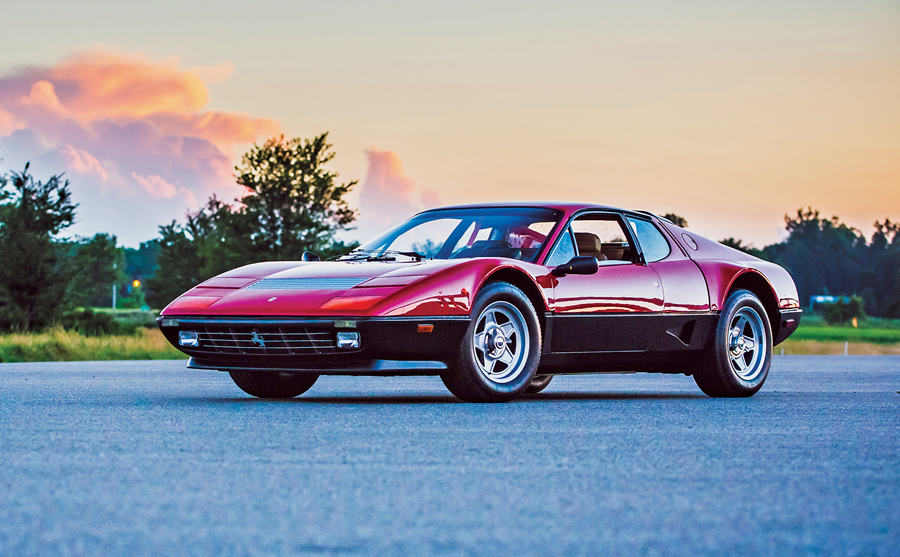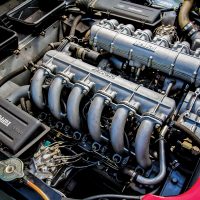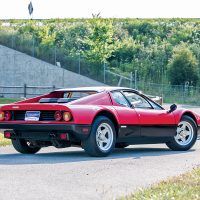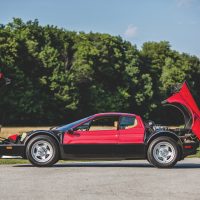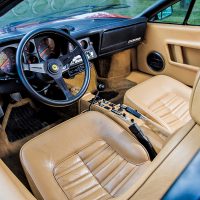SCM Analysis
Detailing
| Vehicle: | 1983 Ferrari 512 BBi |
| Years Produced: | 1982–84 |
| Number Produced: | 1,007 |
| Original List Price: | $62,500, plus an additional $10,000 for DOT/EPA compliance for cars imported into the United States |
| SCM Valuation: | Median to date, $334,880; high sale, $600,000 |
| Tune Up Cost: | $10,000 and up for an engine-out service with belts |
| Distributor Caps: | $500 |
| Chassis Number Location: | On frame tube in engine bay |
| Engine Number Location: | On top of block |
| Club Info: | Ferrari Club of America |
| Website: | http://www.ferrariclubofamerica.org |
| Alternatives: | 1970 DeTomaso Mangusta, 1984 Lamborghini Countach, 1977 Maserati Bora |
| Investment Grade: | B |
This car, Lot 173, sold for $175,000, including buyer’s premium, at Auctions America’s November 5, 2016, sale at Hilton Head Island, SC.
You have to go back in time to begin to understand Ferrari Boxer values. They’ve always been a bit volatile.
You couldn’t just walk into your friendly Ferrari dealer in the late 1970s and early 1980s and buy a Boxer off the showroom floor. The Boxer was Ferrari’s flagship model, but Ferrari didn’t export them to the United States because of the difficulty of making them comply with U.S. safety and emission standards.
It was only through the ingenuity of some independent shops and the determination of some well-heeled enthusiasts that Boxers made their way to the United States.
A booming gray market
During the 1970s and 1980s, a loophole allowed non-U.S.-certified — gray market — cars to be modified to meet U.S. standards. The process was less stringent than the one manufacturers had to meet. With some trial and error, specialists found they could bring some of the most taboo exotic models into compliance with U.S. regulations. In many cases the process was difficult and expensive. Other times the process was surprisingly easy.
While the ability to get a car that otherwise couldn’t be bought in the United States may have given birth to gray-market importation, it was profit that made it explode.
At the time, independent distributors — not manufacturers — imported cars into the U.S. The distributors were free to set their own prices, and those prices were often far more than found in Europe.
The price differential and a favorable currency exchange made many cars far less expensive in Europe. Soon, enterprising independents began importing cars into the U.S. for profit on small and large scales.
There wasn’t an MSRP for U.S.-modified Boxers. Everyone paid a different price, based on what step of the importation they bought in at and the expenses necessary to complete the process.
Lenoir E. Zaiser imported Chassis 44231. Mr. Zaiser is a successful inventor and manufacturer, whose companies fabricated sophisticated parts for Sidewinder missiles — and medical devices. Little is known about his history with the car, but the later history is pretty easy to follow.
A frequent flier — with few miles
Boxer 44231 is an old friend of the RM auction family. Sports Car Market’s Platinum Auction Database marks an appearance at RM Auctions’ 2003 Meadow Hall sale with 16,546 miles showing on the odometer. Our reporter, David Kinney, noted the $71,500 sounded “like current-market money.” He also wrote: “At one time the Boxer was the Ferrari to have, but as with all fashion trends, it fell off a cliff after the next set of models arrived.”
RM sold 44231 again in 2012 at their Amelia Island sale. In roughly nine years the mileage had only increased a scant 322 miles to 16,868 miles. The sale price of $112,750 fell well short of RM’s $120,000–$140,000 estimate, but it was enough over the 2003 sale to make the car a good investment if that was the intent of the purchase.
This time RM’s affiliate, Auctions America, sold the car. The mileage showed 17,169 miles — only a 301-mile increase over the past four-plus years. On the other hand, the sale price of $175,000 had zoomed up by $62,000.
Reading the previous three paragraphs would give you the impression that this Boxer was a pretty good investment, which it was — unless you bought it in the past couple years.
This is where I remind you of David Kinney’s quote, “At one time the Boxer was the Ferrari to have, but as with all fashion trends, it fell off a cliff after the next set of models arrived.” The quote is a remarkable insight into Boxers and the trendy car market in general.
Over the past couple years many late-model cars — if a 30-year-old car can be called late model — have been red hot. Boomers throwing money at cars of their youth became a trend. A lot of money chasing a few cars caused prices to rise quickly. Rapidly rising prices attracted investors, pouring fuel on the fire.
The $120,000 512 BBi of 2012 tripled in value by 2015. That brought out cars that otherwise might not have for sale. By mid-2016, the supply of Boxers exceed demand, and prices starting reversing.
A little late to the party
Since the beginning of August, at least eight Boxers have hit auction blocks. This sale was by far the lowest, but even the highest sale was well under SCM’s Pocket Price Guide’s historical median of $313,500.
Two sellers got lucky in the $280,000 range. The rest floundered with bids in the $220,000 to $250,000 range.
Boxer owners may look at this sale as a disaster, but is the sky really falling? Assume the seller bought chassis 44231 at RM’s 2012 sale, that means he paid $112,750 for it. Not counting expenses, he made nearly $60,000 for enjoying a great Ferrari.
The seller may not have gotten the windfall that he would have last year, but there are few cars on the planet that yielded near the same return.
Shed no tears on this one. The seller won the lottery — just not the big one. ♦
(Introductory description courtesy of Auctions America.)
